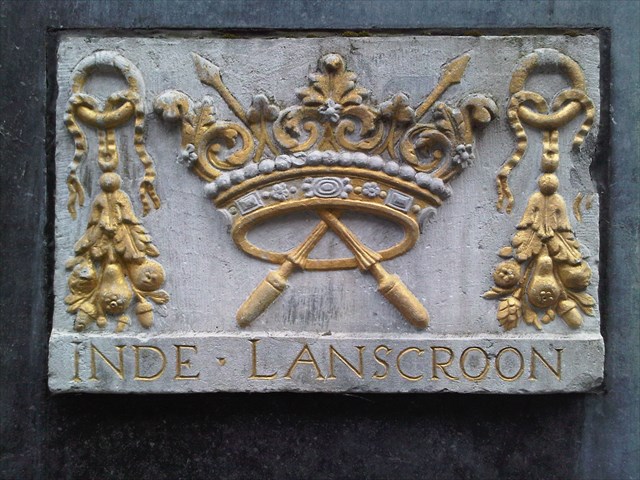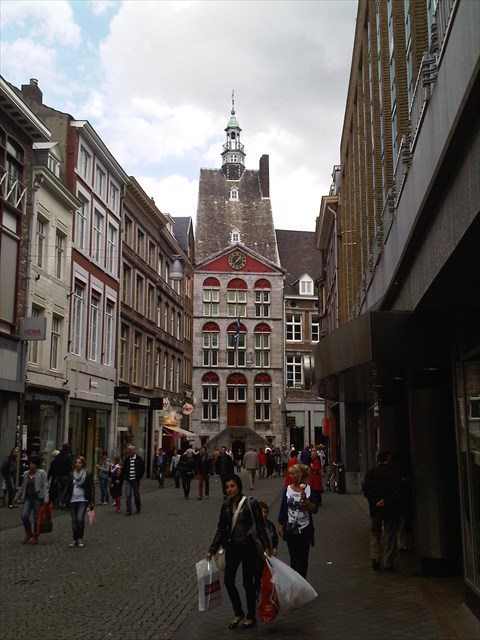De Grote Staat is één van de belangrijkste winkelstraten in het centrum van Maastricht. De aanduiding 'staat' wijst op het stedelijk gezag dat hier vroeger was gevestigd. De Grote Staat ligt in het voetgangersgebied in het oude gedeelte van de vestingstad Maastricht.
De Grote Staat is one of the main shopping streets in the center of Maastricht. The term "Staat" refers to the municipal authority which was located here. De Grote Staat is located in the pedestrian area in the most oldest part of the fortified city of Maastricht.
In de romeinse tijd
Archeologische opgravingen hebben aangetoond dat zich langs het gehele tracé van de Grote Staat, op een diepte van 5 à 6 meter, zich restanten van Romeinse woningen bevinden. Bij opgravingen op het terrein Grote Staat 37-43 (voorheen Maison Louis) in 2010 en 2011 werden onder andere resten van lemen huizen of stallen gevonden. Het was al langer bekend dat er langs de Romeinse hoofdweg, thans aangeduid als Via Belgica, gewoond en gewerkt werd, ook op iets grotere afstand van de nederzettingskern bij de Romeinse brug, thans bekend als "Aw bruk".
De opgraving bevestigt het beeld van Romeins Maastricht als een bescheiden provinciaal-Romeinse nederzetting, bestaande uit een kern van stenen gebouwen (het latere castrum bij de brug), een grote begraafplaats (op het Vrijthof) met daar tussenin langgerekte, op de weg georiënteerde percelen met gebouwen van hout en leem.
In Roman times
Archaeological excavations have shown that there are many remains of Roman houses along the entire route of De Grote Staat, at a depth of 5 to 6 meters. Excavations on the site of the numbers37-43 (formerly Maison Louis) in 2010 and 2011 remains of mud houses and stables were found among others. It was already known that there was trading along the Roman road known as Via Belgica, residents lived and worked, even at a greater distance from the settlement core of the Roman bridge, now known as "Aw bruk".
The excavation confirms the picture of Roman Maastricht as a modest provincial-Roman settlement, consisting of a core of stone buildings (later castrum at the bridge), a large cemetery (on De Vrijthof) with in between elongated, road oriented plots with buildings of wood and clay.


De middeleeuwen
De Grote Staat heette tijdens het Ancien Régime Sint-Jorisstraat, naar de Sint-Joriskapel, die tot 1617 op de hoek van de Spilstraat, naast de Dominicanenkerk was gelegen. De wijkkapel werd al in 1263 genoemd en was ondergeschikt aan het kapittel van Sint-Servaas. Volgens de traditie zou de kapel in 1566 tijdens de Beeldenstorm zijn vernield.
Op de hoek van het Vrijthof en de Grote Staat lag het huis Den Winckel, waar de Luikse bisschoppen vanaf 1443 (en wellicht al eerder) regelmatig verbleven. Jan van Horne woonde er eind 15e eeuw langere tijd. Op 18 juni 1485 kon hij vanaf zijn balkon zijn tegenstander Willem van der Marck, bijgenaamd het 'zwijn van de Ardennen', gadeslaan die bij de Luikse perroen op het Vrijthof werd onthoofd. In de 16e of 17e eeuw werd het huis gesloopt ter verbreding van de Helmstraat. Het toentertijd gebouwde pand stortte in 1969 plotseling in, hetgeen een enorme ravage veroorzaakte.
Het deel van de Grote Staat nabij het Dinghuis werd ook aangeduid als Voor het Kruis vanwege het kruis dat hier waarschijnlijk stond. Schuin tegenover het Dinghuis, waar het hooggerecht was gevestigd, zetelde het burgerlijk bestuur van de stad in twee panden, De Lanscroon en De Liebaert. Deze huizen deden dienst als , laaggerechtshuis, gevangenis, archiefbewaarplaats en stadstaveerne. De Liebart was waarschijnlijk al in de 14e eeuw een woontoren van de familie De Leopardo (of: Van den Liebaerde) en werd later aan De Lanscroon toegevoegd. Vóór De Lanscroon was een overdekt platform, waarop misdadigers aan de konden worden gesteld. Beide huizen werden in 1657 verkocht ten bate van de bouw van het nieuwe stadhuis van Maastricht en bestaan thans niet meer. De gevelsteen van De Lanscroon is ingemetseld in het pand van Vroom & Dreesmann ter plekke.


In Maastricht bestonden geen gilden maar ambachten. De 23 Maastrichtse ambachten hadden ook geen gildehuis, maar een leube (een soort voorkamer of loggia in een gewoon huis of een stadspoort). Een aantal leuben lagen in de Sint-Jorisstraat. Tegenover De Lanscroon, in het pand waar thans de HEMA is gevestigd, lag de leube van de smeden, het smeetshuys genaamd.
The Middle Ages
De Grote Staat was called during the Ancien Régime St. George Street , the St. George 's Chapel , which until 1617 was at the corner of the Spilstraat , in addition to where the Dominican church was located . The district chapel was already mentioned in 1263 and was subordinate to the society of Saint Servatius . According to tradition, the chapel in 1566 would have been destroyed .
During the Iconoclasm
At the corner of the Vrijthof and the Great State was the home of Den Winckel, which stayed the bishops of Liège from 1443 ( and perhaps earlier ) regularly . Jan van Horne lived here late 15th century, for a long time . On June 18, 1485 he could see from his balcony the punishment of his opponent Willem van der Marck , nicknamed the " Boar of the Ardennes ' . In the 16th or 17th century, the house was demolished for widening the Helmstraat . The then constructed building collapsed suddenly in 1969 , which caused a large amount of garbage.
The part of De Grote Staat near Het Dinghuis was also referred to as The Cross because of the cross that was probably here . Diagonally across Het Dinghuis where the high court was established , sat the civil administration of the city in two buildings , De Lanscroon and De Liebaert . These houses were used as , low court house , jail , archival institution and city tavern . The Liebart was probably in the 14th century a tower of the family De Leopardo (or Van den Liebaerde ) and was later added to De Lanscroon . Before De Lanscroon was a covered platform , in which criminals could be executed. The Both homes were sold in 1657 in favor of the construction of the new city hall of Maastricht and no longer exist. Present The plaque of De Landscroon is entombed in the building of Vroom & Dreesmann on the spot .